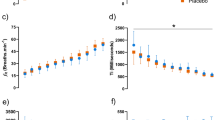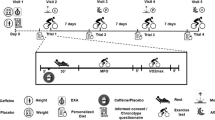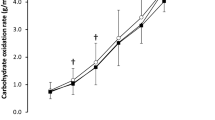Summary
The physiological effects of caffeine on subjects habituated to caffeine is relatively unstudied compared to those of caffeine naive subjects during graded exercise. Thus, the purpose of this investigation was to determine the effects of caffeine on maximal oxygen consumption (VO2max) and the anaerobic threshold in these two populations. Seventeen moderately trained males were classified according to caffeine usage: (1) caffeine consumption 25 mg·day−1 or less (CN) (n=8) or (2) caffeine consumption above 300 mg·day−1 (CH) (n=9). The subjects were tested post-absorptive on the same cycle ergometer on three occasions with 7 days separating the tests. One hour before each test the subject ingested either a gelatin capsule (C); 3 mg·kg−1 body weight of caffeine (C3); or 5 mg·kg−1 body weight of caffeine (C5). The subject then performed an incrementalVO2max test beginning at 50 W and the work rate was increased 30 W every 2 min until the subject could not maintain the power output. Serial venous blood samples were drawn over 30 s at the end of each stage. The CN group significantly increased resting heart rate (f c) and expired ventilation volume (V E) after C3 and C5 andVO2 after C5. No significant differences were found for exerciseV E,VO2, respiratory excharge ratio,f c or time to exhaustion. There were no significant differences (P < 0.05) in the lactate threshold or the ventilatory threshold between treatment in either group. The CH subjects showed a significant increase (P<0.05) in resting plasma free fatty acid (FFA) concentration only during the C3 and C5 treatments. Plasma FFA levels were significantly increased (P < 0.05) at all times during C3 and C5 treatment in the CN subjects when compared to the control values. These data indicate that caffeine has no effect onVO2max or the anaerobic threshold seen during incremental, graded exercise. However, resting metabolism and ventilation, and both resting and exercise plasma FFA are increased in CN subjects.
Similar content being viewed by others
References
Baldwin KM, Campbell PJ, Cooke DA (1977) Glycogen, lactate and alanine changes in muscle fiber types during graded exercise. J Appl Physiol 43:288–291
Caiozzo VJ, Davis JA, Ellis JF, Azus JL, Vandagriff R, Prietto CA, McMaster WC (1982) A comparison of gas exchange indices used to detect the anaerobic threshold. J Appl Physiol 53:1184–1189
Costill DL, Coyle E, Dalsky G, Evans W, Fink W, Hoopes D (1977) Effects of elevated plasma FFA and insulin on muscle glycogen usage during exercise. J Appl Physiol Respir Environ Exerc Physiol 43:695–699
Costill DL, Dalsky G, Fink W (1978) Effects of caffeine ingestion on metabolism and exercise performance. Med Sci Sports Exerc 10:155–158
Curatolo PW, Robertson D (1983) The health consequences of caffeine. Ann Intern Med 98:641–653
Dodd SL, Powers SK, Thompson D, Landry G, Lawler J (1989) Exercise performance following intense, short-term ventilatory work. Int J Sports Med 10:48–52
Erickson MA, Schwarzkopf RJ, McKenzie RD (1987) Effects of caffeine, fructose, and glucose ingestion on muscle glycogen utilization during exercise. Med Sci Sports Exerc 19:579–583
Essig D, Costill DL, Van Handel PJ (1980) Effects of caffeine ingestion on utilization of muscle glycogen and lipid during cycle ergometry. Int J Sports Med 1:86–90
Fisher SM, McMurray RG, Berry M, Mar MH, Forsythe WA (1986) Influence of caffeine on exercise performance in habitual caffeine users. Int J Sports Med 7:276–280
Fitts RH, Holloszy JO (1976) Lactate and contractile force in frog muscle during development of fatigue and recovery. Am J Physiol 231:430–433
Gaesser GA, Rich RG (1985) Influence of caffeine on blood lactate response during incremental exercise. Int J Sports Med 6:207–211
Gladden LB, Yates JW, Stremel RW, Stamford BA (1983) Agreement between gas exchange and lactate anaerobic threshold determinations among independent investigators. Med Sci Sports Exerc 15:121
Green HJ, Hughson RL, Orr GW, Ranney DA (1983) Anaerobic threshold, blood lactate, and muscle metabolites in progressive exercise. J Appl Physiol 54:1032–1038
Ivy J, Costill D, VanHandel P, Essig D, Lower R (1981) Alteration in the lactate threshold with changes in substrate availability. Int J Sports Med 2:139–142
Klausen K, Knuttgen HG, Forster H (1972) Effects of preexisting high blood lactate concentration on maximal exercise performance. Scand J Clin Lab Invest 30:415–419
LeBlanc J, Jobin M, Cote J, Samson P, Labrie A (1985) Enhanced metabolic response to caffeine in exercise-trained human subjects. J Appl Physiol 59:832–837
Lehmann M, Schmid P, Keul J (1985) Plasma catecholamine and blood lactate accumulation during incremental exhaustive exercise. Int J Sports Med 6:78–81
Powers SK, Dodd SL (1985) Caffeine and endurance performance. Sports Med 2:165–174
Powers SK, Byrd RJ, Tulley R, Callender T (1983) Effects of caffeine ingestion on metabolism and performance during graded exercise. Eur J Appl Physiol 50:301–307
Ramadoss CS, Uyeda K, Johnston JM (1976) Studies on the fatty acid inactivation of phosphofructokinase. J Biol Chem 251:98–107
Robertson D, Frolich JC, Carr RK (1978) Effects of caffeine in plasma renin activity, catecholamines and blood pressure. N Engl J Med 298:181–186
Robertson D, Johnson GA, Robertson RM, Nies AS, Shand DG, Oates JA (1979) Comparative assessment of stimuli that release neuronal and adrenomedullary catecholamines in man. Circulation 59:637–642
Robertson D, Wade D, Workman R, Woosley RL, Oates JA (1981) Tolerance to the humoral and hemodynamic effects of caffeine in man. J Clin Invest 67:1111–1117
Rowell LB, Saltin B, Kiens B, Christensen NJ (1986) Is peak quadriceps blood flow in humans even higher during exercise with hypoxemia? Am J Physiol 251:H1038–1044
Supinski GS, Levin S, Kelsen SG (1986) Caffeine effect on respiratory muscle endurance and sense of effort during loaded breathing. J Appl Physiol 60:2040–2047
Sutherland E, Robinson G, Butcher R (1968) Some aspects of the biological role of adenosine 3′,5′-monophosphate (cyclic AMP). Circulation 37:279–306
Tarnopolsky MA, Atkinson SA, Macdougall JD, Sale DG, Sutton JR (1989) Physiological responses to caffeine during endurance running in habitual caffeine users. Med Sci Sports Exerc 21(4):418–424
Toner MM, Kirkendall DT, Delio DJ, Chase JM, Cleary PA, Fox EL (1982) Metabolic and cardiovascular responses to exercise with caffeine. Ergonomics 25:1175–1183
Trippenbach R, Zinman R, Milic-Emili J (1980) Caffeines's effect on breathing patterns and vagal reflexes in newborn rabbits. Respir Physiol 40:211–223
Wasserman K (1984) The anaerobic threshold measurement to evaluate exercise performance. Am Rev Respir Dis 129:S35–S40
Wasserman K, Whipp BJ, Koyal SN, Beaver WL (1973) Anaerobic threshold and respiratory gas exchange during exercise. J Appl Physiol 35:236–243
Weber A, Herz R (1968) The relationship between caffeine contracture of intact muscle and the effect of caffeine on reticulum. J Gen Physiol 52:750–759
Winder WW (1986) Effect of intravenous caffeine on liver glycogenolysis during prolonged exercise. Med Sci Sports Exerc 18:192–196
Author information
Authors and Affiliations
Rights and permissions
About this article
Cite this article
Dodd, S.L., Brooks, E., Powers, S.K. et al. The effects of caffeine on graded exercise performance in caffeine naive versus habituated subjects. Europ. J. Appl. Physiol. 62, 424–429 (1991). https://doi.org/10.1007/BF00626615
Accepted:
Issue Date:
DOI: https://doi.org/10.1007/BF00626615




